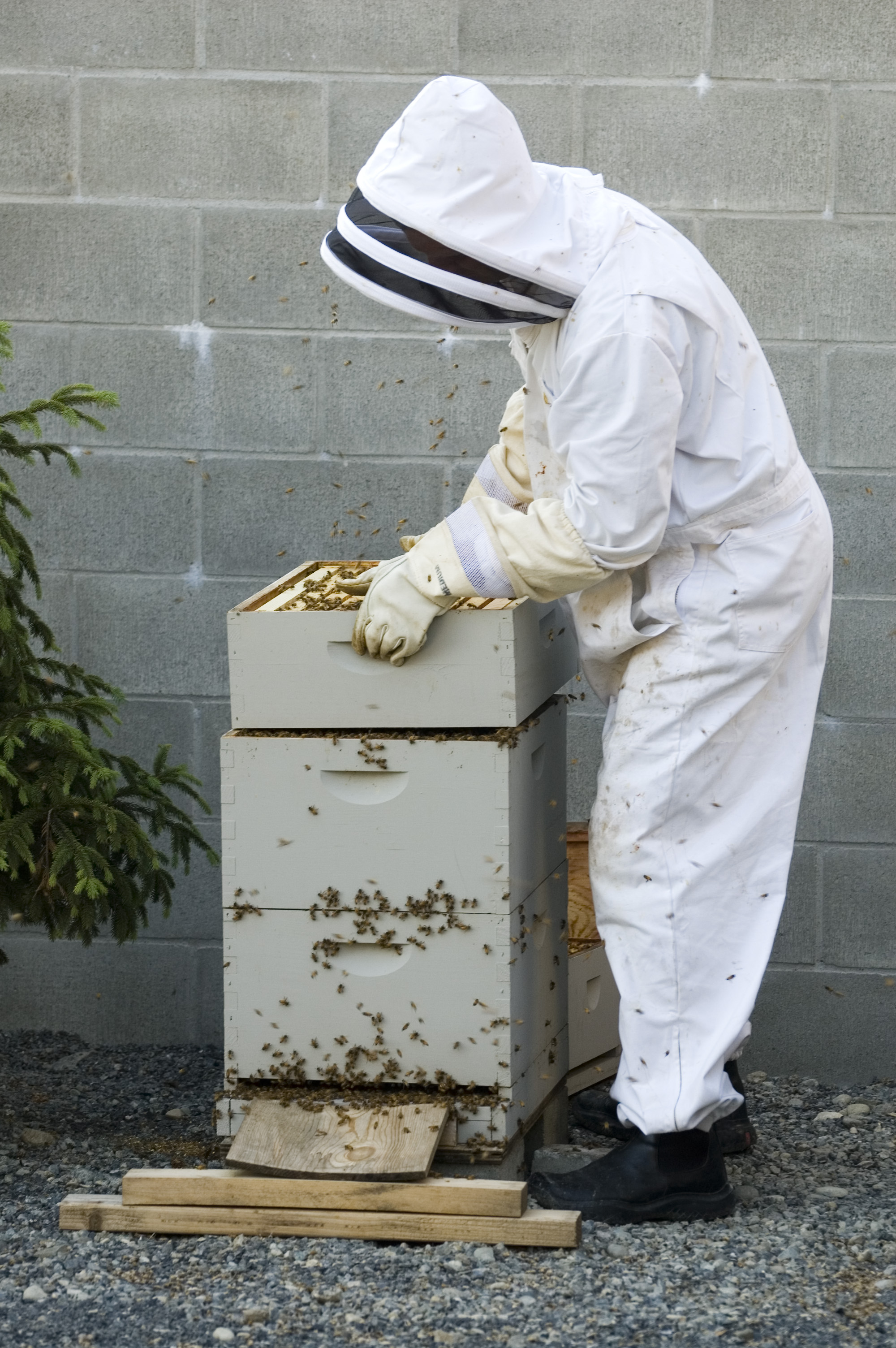 (Photo: Lucas Anderson/Neighborlogs.com)
(Photo: Lucas Anderson/Neighborlogs.com)
For the second segment on Central District urban agriculture, I visited the home of Chris Rogers. It’s hard to believe that the walls of a steel-clad house on Olive contains a lover of agriculture. After a summer school program he attended when he was in middle school, Rogers became hooked on what became a life long passion: bees.
Hidden behind a stone wall, his hives are easier heard than seen, spewing bees protecting their precious honey. “Bee keeping is the next step after a vegetable garden”, says Rogers, who has been doing urban agriculture for years. Compared to chickens, bees are a little less friendly (and seemed to be particularly spiteful towards reporters). “I probably get stung every time I’m out with them” he said, despite having a beekeeping suit. But the drawbacks to bees end with the stinging, as Rogers harvests gallons of honey each year to be used in cooking, eating, and for gifts. He even notes the stings tend to make his joints feel better, referencing Apitherapy, or the medical use of honeybee products.
While the upfront cost to start beekeeping is high, maintaining the hives is low cost, and if you aren’t afraid of bees, fairly easy. Rogers checks on his hives every two weeks, and harvests two times a year. Seattle law on beekeeping requires you to register with the State Department of Agriculture and limits the number of hives to 4 on an average lot. Also, the city requires a solid fence if the hives are too close to the edge of your property.
For more information, The Puget Sound Beekeepers Association, which Rogers is a member of, meets monthly to discuss beekeeping and other bee related topics.

cool
I know the house you’re talking about (or else there’s another metal house with bee hives on Olive). I’m amazed it isn’t required to install a full fence. The hives are not behind a wall, they are in the concrete-covered, completely unfenced front yard. There’s nothing separating them from the sidewalk just a few feet away.
I’m allergic to bee stings and this situation is sketchy enough that I’ve started walking a different route to the bus. Homemade honey is cool, but I have to admit I’m not a huge fan of this particular setup. I know a few other folks who keep bees and they’ve done a much better job of ensuring their hives don’t cause issues for other folks.
Thanks for keeping bees, Chris. All us other gardeners need them for pollination. I hope some head from my squash blossoms home to your hive. (And thanks for a cool article, Lucas. I hope your stings heal smoothly!)
love it love it love it!! great article- so inspiring!!!
That’s where my bees are coming from! Good to know!
Also, wild bees are an interesting subject for study. See: http://www.knoxcellars.com
That’s neat–I didn’t realize one could buy / raise Mason bees like that.
I see some wild Mason bees around our place in Madison Valley–we have cedar shingle siding on our house, which I have to watch closely during the summer for local pests of the wasp persuasion: yellow jacks and hornets (the yellow jackets are the more regular nuisance).
But there are always a few Mason bees I find hanging out in the shingles, and they’re welcome since they’re solo (no hives) and keep to pollinating the flowers rather than going after our picnics. Just a couple little guys / gals on their own living in our shingles and going out and working on our garden everyday–cool bees!
I welcome all the bees we can get at Judkin’s P-patch. As a gardener, honey lover, and worried citizen of the world I am happy with anyone who is taking to tiem out to nuture and protect bees!
Speaking of urban agriculture, our zucchini plants were ripped out of our front yard on 28th ave today. Probably random violence. Totally sucks. :(
And thanks Chris, for the bees!
where all the bees are this summer near me and it would be nice if someone in my neighborhood had some hives. I grow lavender, lupine and lots of flowers and butterfly bushes..
This little guy seems to be the lone one that comes by every day, and has his fill. I saw him in the lupines then noticed he went to the rosemary, which has no flowers. Seems he wanted to take little nap.
http://www.centraldistrictnews.com/2009/07/10/ktkeller/bee-n
are you missing the 1.5 ft thick concrete wall that separates the bees from passers by?
Way cool!! Never thought you could keep bees in the city!